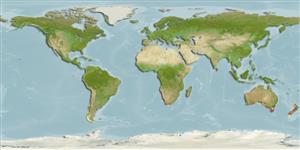Common names from other countries
Classification / Names / Names
Nomi Comuni | Sinonimi | Catalog of Fishes (gen., sp.) | ITIS | CoL | WoRMS
Environment: milieu / climate zone / depth range / distribution range
Ecologia
; distribuzione batimetrica 0 - 100 m (Ref. 105682). Tropical; 26°S - 57°S, 76°W - 175°W
Southern Atlantic and Indo-Pacific.
Length at first maturity / Size / Peso / Age
Maturity: Lm ? range ? - ? cm Max length : 13.5 cm SHL maschio/sesso non determinato; (Ref. 109255)
Maximum depth from Ref. 105658. Found on or around coastal rocks (Ref. 82479), intertidal rocks and at depths of 40 to 100 m (Ref. 105658). Most specimens are trawled or dredged on the shelff at depths of 20 to 100 m (Ref. 122471). Species under the family Ranellidae are carnivorous mesogastropods known to feed on polychaetes, bivalves, ascidians, gastropods, echinoderms and crustaceans (Ref. 69146). Illustrated feeding on the ascidian Sycozoa sp. (Ref. 106980).
Life cycle and mating behavior
Maturità | Riproduzione | Deposizione | Uova | Fecundity | Larve
Members of the order Neotaenioglossa are mostly gonochoric and broadcast spawners. Life cycle: Embryos develop into planktonic trocophore larvae and later into juvenile veligers before becoming fully grown adults.
Rosenberg, G. 2009. (Ref. 83435)
IUCN Red List Status (Ref. 130435)
CITES status (Ref. 108899)
Not Evaluated
Not Evaluated
Human uses
Pesca: commerciale
| FishSource |
Strumenti
Informazioni ulteriori
Age/SizeAccrescimentoLength-weightLength-lengthMorfologiaLarveAbbondanza
Fonti Internet
Estimates based on models
Preferred temperature
(Ref.
115969): 13.4 - 17.2, mean 15.6 (based on 125 cells).
Price category
Unknown.
